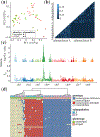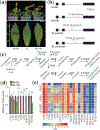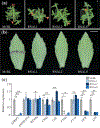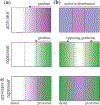To stripe or not to stripe: the origin of a novel foliar pigmentation pattern in monkeyflowers (Mimulus)
- PMID: 36101514
- PMCID: PMC10601762
- DOI: 10.1111/nph.18486
To stripe or not to stripe: the origin of a novel foliar pigmentation pattern in monkeyflowers (Mimulus)
Abstract
The origin of phenotypic novelty is one of the most challenging problems in evolutionary biology. Although genetic regulatory network rewiring or co-option has been widely recognised as a major contributor, in most cases how such genetic rewiring/co-option happens is completely unknown. We have studied a novel foliar pigmentation pattern that evolved recently in the monkeyflower species Mimulus verbenaceus. Through genome-wide association tests using wild-collected samples, experimental crosses of laboratory inbred lines, gene expression analyses, and functional assays, we identified an anthocyanin-activating R2R3-MYB gene, STRIPY, as the causal gene triggering the emergence of the discrete, mediolateral anthocyanin stripe in the M. verbenaceus leaf. Chemical mutagenesis revealed the existence of upstream activators and repressors that form a 'hidden' prepattern along the leaf proximodistal axis, potentiating the unique expression pattern of STRIPY. Population genomics analyses did not reveal signatures of positive selection, indicating that nonadaptive processes may be responsible for the establishment of this novel trait in the wild. This study demonstrates that the origin of phenotypic novelty requires at least two separate phases, potentiation and actualisation. The foliar stripe pattern of M. verbenaceus provides an excellent platform to probe the molecular details of both processes in future studies.
Keywords: R2R3-MYB; anthocyanin; genetic regulatory network (GRN); monkeyflowers (Mimulus); phenotypic novelty; pigmentation pattern.
© 2022 The Authors. New Phytologist © 2022 New Phytologist Foundation.
Figures






References
-
- Arnoult L, Su KFY, Manoel D, Minervino C, Magriña J, Gompel N, Prud’homme B. 2013. Emergence and diversification of fly pigmentation through evolution of a gene regulatory module. Science 339:1423–1426. - PubMed
-
- Beardsley PM, Yen A, Olmstead RG. 2003. AFLP phylogeny of Mimulus section Erythranthe and the evolution of hummingbird pollination. Evolution 57:1397–1410. - PubMed
Publication types
MeSH terms
Substances
Grants and funding
LinkOut - more resources
Full Text Sources
Miscellaneous

